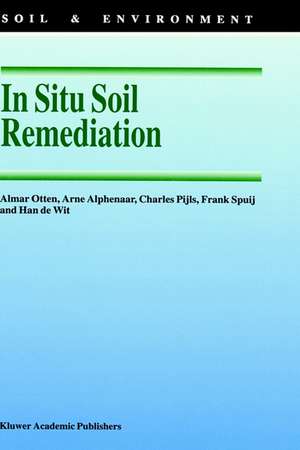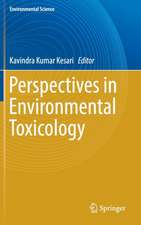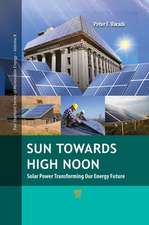In Situ Soil Remediation: Soil & Environment, cartea 6
Autor A.M. Otten, Arne Alphenaar, Charles Pijls, Frank Spuij, Han de Witen Limba Engleză Hardback – 30 sep 1997
Their results have demonstrated that in situ techniques are a mature alternative to conventional remediation techniques. Irrespective of future policy developments, it is impossible to imagine future remediation practice without the use of in situ techniques.
The book presents an overview of recent developments in the field of in situ soil remediation. The book is unique in that it is not a compilation of unrelated case studies. A conceptual approach has been chosen; remediation models described in this book are illustrated from a practical point of view. The authors present the Dutch way of treating contaminated land; The Netherlands is renowned for being at the forefront of remediation techniques as a result of the country's progressiveness and experience in this area.
Toate formatele și edițiile
| Toate formatele și edițiile | Preț | Express |
|---|---|---|
| Paperback (1) | 632.05 lei 6-8 săpt. | |
| SPRINGER NETHERLANDS – 16 oct 2012 | 632.05 lei 6-8 săpt. | |
| Hardback (1) | 638.11 lei 6-8 săpt. | |
| SPRINGER NETHERLANDS – 30 sep 1997 | 638.11 lei 6-8 săpt. |
Preț: 638.11 lei
Preț vechi: 750.72 lei
-15% Nou
Puncte Express: 957
Preț estimativ în valută:
122.11€ • 127.91$ • 101.20£
122.11€ • 127.91$ • 101.20£
Carte tipărită la comandă
Livrare economică 09-23 aprilie
Preluare comenzi: 021 569.72.76
Specificații
ISBN-13: 9780792346357
ISBN-10: 0792346351
Pagini: 116
Ilustrații: IV, 116 p.
Dimensiuni: 170 x 244 x 8 mm
Greutate: 0.35 kg
Ediția:1997
Editura: SPRINGER NETHERLANDS
Colecția Springer
Seria Soil & Environment
Locul publicării:Dordrecht, Netherlands
ISBN-10: 0792346351
Pagini: 116
Ilustrații: IV, 116 p.
Dimensiuni: 170 x 244 x 8 mm
Greutate: 0.35 kg
Ediția:1997
Editura: SPRINGER NETHERLANDS
Colecția Springer
Seria Soil & Environment
Locul publicării:Dordrecht, Netherlands
Public țintă
ResearchCuprins
1 Introduction.- 1.1 What is in situ soil remediation?.- 1.2 Organization of this book.- 2 Processes Underlying in Situ Remediation Techniques.- 2.1 Introduction.- 2.2 The soil system and soil structure.- 2.3 Speciation of contaminants.- 2.4 Transport.- 2.5 Microbiological degradation.- 3 How to Apply in Situ Soil Remediation.- 3.1 Removal processes.- 3.2 Flushing.- 3.3 Soil vapour extraction.- 3.4 Sparging.- 3.5 In situ biorestoration.- 3.6 Special techniques.- 3.7 Remediation concepts.- 3.8 Conceptual in situ remediation models.- 4 From Investigation to Remediation Practice.- 4.1 Introduction.- 4.2 From investigation to execution.- 5 Practice Cases.- 5.1 Introduction.- 5.2 Practice case 1: Sparging and soil vapour extraction, Gennep.- 5.3 Practice case 2: Soil vapour extraction and lowering of groundwater level, Denekamp.- 5.4 Practice case 3: Soil vapour extraction as a containment measure, Arnhem.- 5.5 Practice case 4: In-situ biorestoration of a phthalates contamination using only sparging.- 5.6 Practice case 5: Flushing with acidified water, Soestduinen.- 5.7 Costs.- 6 Bottlenecks.- 6.1 Introduction.- 6.2 Lack of technical tools and knowledge.- 6.3 Bottlenecks caused by the complexity of the soil system.- 7 Most Frequently Asked Questions.- 8 The Role of in Situ Remediation in the Remediation Practice.- 8.1 Introduction.- 8.2 Role of in situ remediation within the classical remediation practice.- 8.3 The role of in situ remediation in remediation variants aimed at minimization of the risks posed to individuals and the ecosystem.- 8.4 In situ remediation and long-lasting, more extensive remediation concepts.- 8.5 In situ soil remediation and sustainable soil management.- 8.6 Irrespective of the developments.- 9 Reference List.- Appendix 1: Substance constants list.
Recenzii
`This well-written, slim, Volume 6 in the Soil & Environment series presents a valuable introduction to the topic of in situ soil remediation. I would be glad to use this book for the introductory courses on remediation offered to our professionals in the environmental field.'
Soil Science, 164:12 (1999)
Soil Science, 164:12 (1999)




















